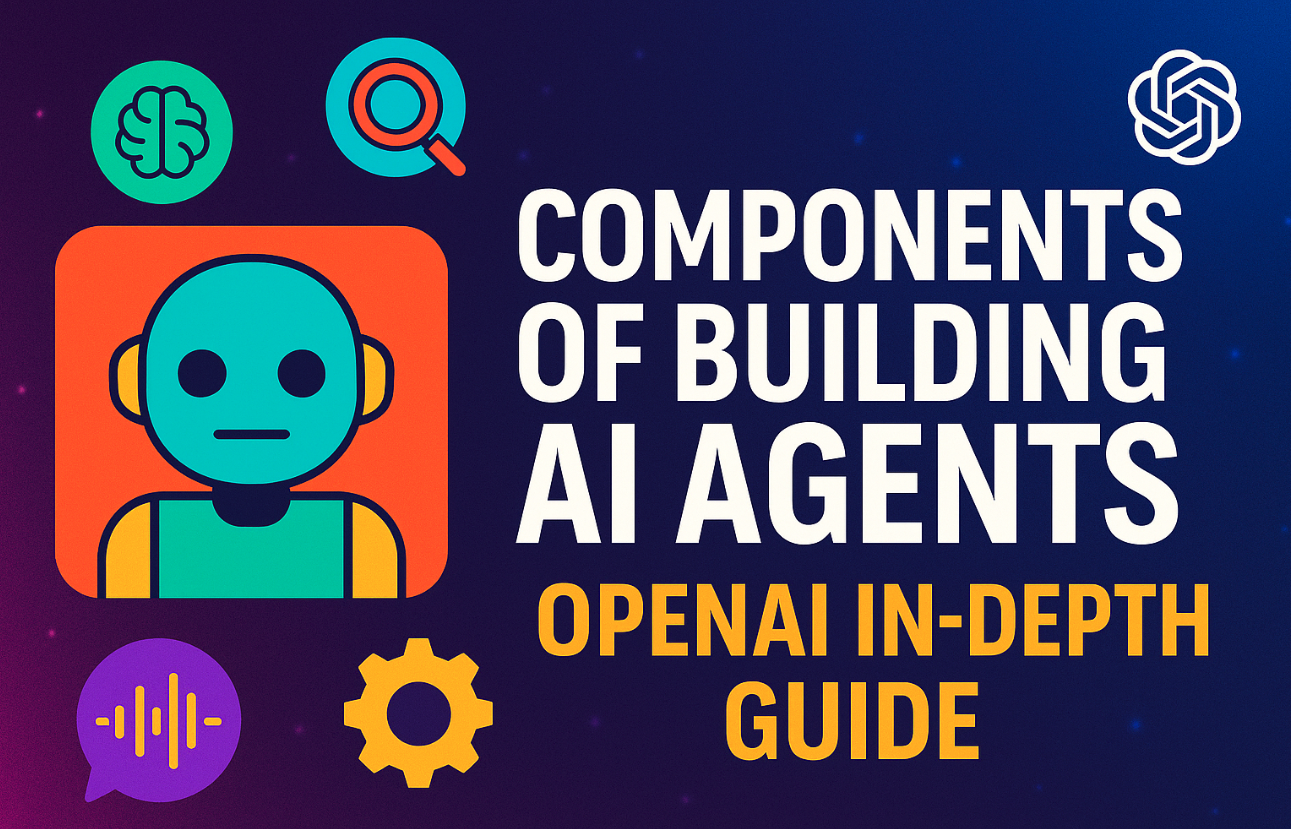Components of Building AI Agents: OpenAI In-Depth Guide!
Artificial Intelligence (AI) agents represent a significant advancement in AI technology, providing sophisticated solutions capable of independent reasoning, real-world interaction, and adaptive responses. Building AI agents involves assembling components across multiple domains, including AI models, tools, knowledge bases, audio capabilities, safety mechanisms, and orchestration methods. In this comprehensive guide, we'll explore each of these critical domains in detail and examine the powerful tools provided by OpenAI to simplify and accelerate AI agent creation.
Understanding AI Agent Components
Before discussing the specifics, it’s essential to understand that AI agents are not singular entities. Instead, they are integrated systems comprising multiple interconnected components, each fulfilling unique roles and tasks.
1. Models: The Cognitive Core
Models constitute the cognitive foundation of AI agents. They enable reasoning, decision-making, content generation, and multimodal data processing. Choosing an appropriate model is critical to your agent’s success, as different tasks demand varied cognitive capabilities.
OpenAI Model Primitives:
GPT-4o and GPT-4.5: Highly capable of complex reasoning, understanding context, and sophisticated decision-making.
o3-mini and GPT-4o-mini: Lightweight models optimised for tasks requiring speed and efficiency, such as basic conversational interfaces or quick data queries.
Practical Application:
GPT-4.5 or GPT-4o: Ideal for advanced data analysis, in-depth customer support scenarios, or complex decision-making contexts.
o3-mini: Suited for simpler, high-frequency interactions like FAQs and automated response systems.
2. Tools: Enabling Real-World Interaction
Tools allow AI agents to interface with their environments, execute functions, and interact directly with external systems, databases, and web interfaces.
OpenAI Tool Primitives:
Function Calling: Enables direct interaction with software applications through API-like integrations.
Web and File Search: Empowers agents to retrieve and analyse relevant external information in real-time.
Computer Use: Allows agents to interact with applications and websites directly, mimicking human interactions such as clicking buttons or completing forms.
Practical Application:
A financial AI agent uses function calling to interact directly with transaction databases.
Customer service agents utilise web search tools to fetch and provide up-to-date information from external resources.
3. Knowledge and Memory: Empowering Contextual Understanding
Knowledge and memory components enable AI agents to store, retrieve, and utilise historical and contextual information, greatly enhancing interaction quality and accuracy.
OpenAI Knowledge and Memory Primitives:
Vector Stores and Embeddings: Facilitate semantic search capabilities and rapid retrieval of relevant historical context or stored information.
File Search: Allows agents to quickly access and process stored documents and external databases, ensuring responses remain accurate and informed.
Practical Application:
A legal advice AI agent accesses previous case files through vector embeddings, efficiently providing contextually accurate responses.
A marketing analysis agent retrieves historical market data to create informed forecasts and trends analysis.
4. Audio and Speech: Humanising Interaction
Audio and speech functionalities ensure agents can understand spoken language and respond naturally, vastly improving user experience and engagement.
OpenAI Audio Primitives:
Audio Generation: Produces natural-sounding speech from text.
Real-time Audio Agents: Enable live interactions with users through voice inputs and outputs, suitable for conversational interfaces and voice assistants.
Practical Application:
Smart home devices leverage real-time audio agents for intuitive, hands-free user interaction.
Customer support platforms use audio generation to deliver personalised voice responses.
5. Guardrails: Ensuring Safe and Ethical Operations
Safety and reliability are paramount in deploying AI agents. Guardrails help mitigate risks by preventing inappropriate, harmful, or erroneous agent behaviour.
OpenAI Guardrail Primitives:
Moderation: Filters and manages agent interactions, ensuring compliance with ethical and organisational standards.
Instruction Hierarchy: Defines clear behavioural guidelines and boundaries for agent responses, significantly enhancing reliability and appropriateness.
Practical Application:
Medical advisory agents utilise moderation to avoid giving unverified medical advice.
Financial services AI agents use instruction hierarchies to ensure compliance with regulatory frameworks.
6. Orchestration: Managing and Enhancing Agents
Orchestration involves deploying, monitoring, optimising, and scaling AI agents effectively within real-world environments.
OpenAI Orchestration Primitives:
Agents SDK: Streamlines the creation, testing, and deployment processes of AI agents, offering extensive customisation capabilities.
Tracing and Evaluations: Provide detailed insights into agent behaviours, performance metrics, and interaction patterns.
Fine-tuning: Allows incremental improvements to agent models, enhancing performance based on feedback and operational data.
Practical Application:
Enterprise-level customer service platforms manage and improve hundreds of deployed AI agents via extensive tracing and fine-tuning.
Developers rapidly prototyping and scaling agent capabilities using the streamlined Agents SDK.
7. Voice Agents: Enhancing Real-Time Interaction
Voice agents combine speech understanding and generation capabilities, offering seamless, intuitive interaction experiences for users.
OpenAI Voice Agent Primitives:
Realtime API: Facilitates instant speech-to-text and text-to-speech conversion for dynamic voice interactions.
Voice Support in Agents SDK: Simplifies the integration and deployment of voice-based conversational agents.
Practical Application:
Interactive virtual assistants in automotive systems, enhancing driver safety and convenience through voice commands.
Voice-enabled educational platforms are improving accessibility and learner engagement.
Building an Effective AI Agent: A Structured Approach
Creating powerful AI agents involves systematically combining these primitives to meet specific goals:
Define Clear Objectives: Identify the agent’s primary tasks and required interactions.
Select Appropriate Components: Match agent objectives to suitable models, tools, and knowledge resources.
Establish Guardrails and Safety Measures: Implement moderation and instruction hierarchies to ensure safe operations.
Integrate Orchestration Methods: Employ SDKs and evaluation tools to continuously monitor, refine, and enhance agent performance.
The Future…..
The landscape of AI agent development is rapidly evolving. With ongoing innovations from OpenAI and other industry leaders, we anticipate further enhancements in agent sophistication, accessibility, and usability. Future developments will likely include more advanced multimodal capabilities, deeper contextual understanding, and increasingly intuitive user interactions.
Conclusion
Building AI agents is now more accessible and effective than ever, thanks to composable primitives provided by OpenAI. By strategically integrating models, tools, knowledge, speech capabilities, guardrails, and orchestration techniques, developers and businesses can create robust, intelligent agents tailored for virtually any application. Embracing these technologies today positions innovators at the forefront of the AI revolution, ready to harness the full potential of intelligent automation and interaction.
